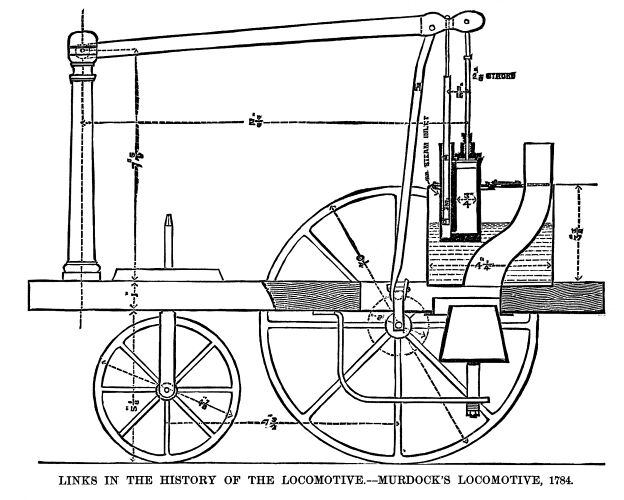LINKS IN THE HISTORY OF
THE LOCOMOTIVE.
Scientific American Supplement—August
6, 1881
IN Smiles' "Lives of the Engineers," in the volume
of the 1874 edition devoted to George and Robert Stephenson, will
be found a very small engraving which is a longitudinal section
of Murdock's locomotive. In the "Life of Trevithick,"
by his grandson, and published by Messrs. Spon, in 1872, will
be found a small section of the machine. We are not aware of the
existence of any other section of this little engine, save that
which we publish on next page. The machine is the property of
Mr. Murdock, manager of the Sun Foundry, Leeds, and grandson of
William Murdock, the friend of Watt, and the maker of the little
locomotive in question. Smiles gives no dimensions or details.
Mr. Murdock has, however, recently taken the engine to pieces,
and had a drawing made from it fully dimensioned, and we are indebted
to him for a tracing from this drawing, by the aid of  which our engraving has been prepared.
Mr. Murdock has had the engine under steam, and found that it
readily made one hundred revolutions a minute when supported with
the driving wheels off the ground. It is one of the most interesting
mechanical relics in existence; for there is no reason to doubt
that it is the first locomotive steam engine ever made in England.
The first locomotive ever constructed was built by Cugnot, a French
engineer. The original model was made in 1763, and the machine
itself was tried in 1769. It was not successful because the boiler
was too small. In 1772 Oliver Evans, in America, invented a steam
carriage to travel on common roads. In 1784 William Symington
made, it is said, a model of a locomotive in Scotland, and in
the same year Murdock produced the model we illustrate. It was
not until 1802 that Richard Trevithick, Murdock's pupil, took
up the subject. Those who wish to learn what be did will find
it fully recorded in "The Life of Trevithick," referred
to above. which our engraving has been prepared.
Mr. Murdock has had the engine under steam, and found that it
readily made one hundred revolutions a minute when supported with
the driving wheels off the ground. It is one of the most interesting
mechanical relics in existence; for there is no reason to doubt
that it is the first locomotive steam engine ever made in England.
The first locomotive ever constructed was built by Cugnot, a French
engineer. The original model was made in 1763, and the machine
itself was tried in 1769. It was not successful because the boiler
was too small. In 1772 Oliver Evans, in America, invented a steam
carriage to travel on common roads. In 1784 William Symington
made, it is said, a model of a locomotive in Scotland, and in
the same year Murdock produced the model we illustrate. It was
not until 1802 that Richard Trevithick, Murdock's pupil, took
up the subject. Those who wish to learn what be did will find
it fully recorded in "The Life of Trevithick," referred
to above.
The Murdock model has been exhibited many times, and it is
to be regretted that it does not now repose in some museum where
it could be seen, while it remained in perfect safety. It consists
of a flat board, at one end of which is a wooden upright, on which
is pivoted a wooden beam. The cylinder is placed underneath the
other end of this beam. This slide valve is actuated by a tappet
motion, the beam striking it up and down alternately at each end
of the stroke. The connecting rod has a transverse joint near
the top, intended, no doubt, to compensate for imperfect workmanship,
in the same way that Watt used a universal joint in his earlier
connecting rods, as may be seen, for instance, in a Watt engine
which is, or was until a very recent date, at work at Messrs.
Frost's rope works in Bermondsey. The disk seen round the vertical
pivot of the steering wheel is a leaden weight, apparently put
on to keep the front of the engine down, and so make it steer
better. The boiler is of copper. The details are too clearly shown
to make further description necessary.—The Engineer.
Antebellum
RR | Contents Page
|







